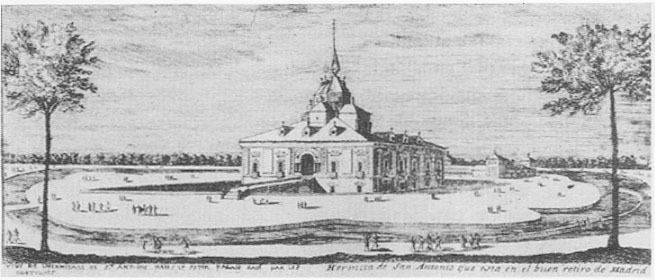 | ||
Real Fábrica del Buen Retiro (popularly called La China; translation, "Buen Retiro Porcelain Factory"; alternate, Real Fabrica de Porcelana del Buen Retiro) was a porcelain manufacturing factory in Spain. It was located in Madrid's Jardines del Buen Retiro on a site near the Fuente del Ángel Caído.
Contents
1700s
The factory was founded in 1760 on a site in the Buen Retiro park which at that time was the private gardens of a royal palace on the outskirts of Madrid. It was an initiative of Carlos III of Spain, who succeeded to the Spanish throne in 1759, and his wife, Maria Amalia of Saxony.
Prior to becoming King of Spain, Charles reigned as King of Naples and Sicily. A similar factory, the Porcellana di Capodimonte, had been established by the royal couple in Naples. Maria Amalia died in 1760, a year after moving to Madrid with her husband, but she was an important influence on both the Naples and the Madrid factories. 53 specialized Italian craftsmen from Naples came to Madrid, along with three shipments containing the necessary equipment and special paste, to establish a factory to produce royal porcelain in Madrid. Gaetano Schepers was in charge of the factory and ten Spanish artists were also associated with the manufacturing. The porcelain's quality was internationally recognized, and its manufacturing techniques were kept a state secret. Buen Retiro porcelain was one of the products that drove mercantilist royal policy during the Spanish Age of Enlightenment. There were other factories in the Madrid area producing luxuries such as tapestries, glass etc.
The factory’s range of products produced between 1770 and 1775 included sculptures, porcelain plaques, dinner services, and artificial flower bouquets. Two revetments of porcelain comprising Gabinetes de la Porcelana made by factory’s artists were installed at Aranjuez and at Madrid. At the Aranjuez Palace the Gabinete de la Porcelana (1760–65), made in situ by Giuseppe Gricci, is covered with white porcelain plaques embellished with motifs of reliefs in coloured chinoiseries. Another Gabinete de la Porcelana was installed at the Royal Palace of Madrid. Improvements in use of material were made by developing soft paste porcelain in Late Baroque style patterned on the lines of Capodimonte. The porcelain room at the Casita del Principe, El Escorial, displays late eighteenth-century ceramic plaques designed in a neoclassical style strongly influenced by Wedgwood Jasperware. Many of the other pieces produced were for the Royal Palace and Patrimonio Nacional. The warehouse opened for public viewing and sales after the King died.
1800s
The year 1803 marked a transition in the factory management from the Italian board of directors to the Spanish-born Bartolome Sureda y Miserol. During his career, Sureda directed several royal factories, including the Real Fabrica de Pano in Guadalajara, the Real Fabrica de Loza de la Moncloa, and the Real Fábrica de Cristales de La Granja.
In 1812, during the Peninsular War, orders came from Wellington to burn the factory and it ceased production. The building had been fortified by the French, but it has been suggested that its destruction was prompted by considerations of commercial rivalry on the part of the British. In 1817, the Buen Retiro factory's successor became the Royal Factory of La Moncloa, founded by Ferdinand VII, who moved the Buen Retiro workshops and warehouses to La Moncloa. Sureda became director again in 1821. All of the employees of the destroyed factory were re-employed in the new one.
Collections
The Casita del Príncipe of El Escorial has a room entirely decorated with Buen Retiro porcelain. Also, in the Royal Palace of Madrid, an entire room has it walls covered with this materials from the royal factory. However, the factory's masterpieces are mainly displayed in the Gabinete de la Porcelana at the Royal Palace of Aranjuez; these were designed and created by the Italian potter, Giuseppe Gricci and his team. A fine collection of porcelain from the factory was put on display in the Museo Municipal de Madrid in the 1830s.
